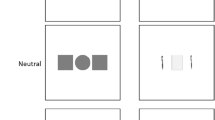Abstract
The influence of stimulus salience on over-selective responding was investigated in the context of a comparator theory of over-selectivity. In Experiments 1 and 2, participants were presented with two cards, each displaying two colors. In comparison to matched control participants, participants with Autistic Spectrum Disorder (ASD) demonstrated more over-selectivity, which increased when the stimuli differed in salience. In Experiment 3, the over-selected color was extinguished, and the previously under-selected color emerged to control behavior. The results suggest that stimuli of different salience may trigger over-selectivity in individuals with ASD, and provide preliminary support that this may be due to the action of an over-sensitive comparator mechanism functioning at the retrieval level of processing.



Similar content being viewed by others
References
American Psychiatric Association. (1994). Diagnostic and statistical manual of mental disorders (4th ed.). Washington, DC: American Psychiatric Association.
Broomfield, L., McHugh, L., & Reed, P. (2008a). Re-emergence of under-selected stimuli, after the extinction of over-selected stimuli in an automated match to samples procedure. Research in Autism Spectrum Disorders.
Broomfield, L., McHugh, L., & Reed, P. (2008b). The effect of observing response procedures on the reduction of over -selectivity in a match to sample task: Immediate but not long term benefits. Research in Developmental Disabilities, 29, 217–234. doi:10.1016/j.ridd.2007.04.001.
Dickson, C. A., Wang, S. S., Lombard, K. M., & Dube, W. V. (2006). Over-selective stimulus control in residential school students with intellectual disabilities. Research in Developmental Disabilities, 27, 618–631. doi:10.1016/j.ridd.2005.07.004.
Dube, W. V., Lombard, K. M., Farren, K. M., Flusser, D., Balsamo, L. M., & Fowler, T. R. (1999). Eye tracking assessment of stimulus overselectivity in individuals with mental retardation. Experimental Analysis of Human Behavior Bulletin, 13, 267–271.
Dube, W. V., & McIlvane, W. J. (1999). Reduction of stimulus over selectivity with nonverbal differential observing responses. Journal of Applied Behavior Analysis, 32, 25–33. doi:10.1901/jaba.1999.32-25.
Gutowski, S. J., Geren, M., Stromer, R., & Mackay, H. A. (1995). Restricted stimulus control in delayed matching to complex samples: A preliminary analysis of the role of naming. Experimental Analysis of Human Behavior Bulletin, 13, 18–24.
Hughes, C., Russell, J., & Robbins, T. W. (1994). Evidence for executive dysfunction in autism. Neuropsychologia, 32, 477–492. doi:10.1016/0028-3932(94)90092-2.
Kemner, C., & van-Engeland, H. (2006). ERPs and eye movements reflect atypical visual perception in pervasive developmental disorder. Journal of Autism and Developmental Disorders, 36, 45–54. doi:10.1007/s10803-005-0041-6.
Koegel, R. L., & Wilhelm, H. (1973). Selective responding to multiple cues by autistic children. Journal of Experimental Child Psychology, 15, 442–453. doi:10.1016/0022-0965(73)90094-5.
Lovaas, O. I., Koegel, R. L., & Schreibman, L. (1979). Stimulus over-selectivity in ASD: A review of research. Psychological Bulletin, 86(6), 1236–1254. doi:10.1037/0033-2909.86.6.1236.
Lovaas, O. I., & Schreibman, L. (1971). Stimulus over-selectivity of autistic children in a two stimulus situation. Behaviour Research and Therapy, 9, 305–310. doi:10.1016/0005-7967(71)90042-8.
Lovaas, O. I., Schreibman, L., Koegel, R., & Rehm, R. (1971). Selective responding by autistic children to multiple sensory input. Journal of Abnormal Psychology, 77, 211–222. doi:10.1037/h0031015.
McHugh, L., & Reed, P. (2007). Age trends in stimulus over-selectivity. Journal of the Experimental Analysis of Behavior, 88, 369–380. doi:10.1901/jeab.2007.88-369.
Miller, R. R., & Schachtman, T. R. (1985). The several roles of context at the time of retrieval. In P. D. Balsam & A. Tomie (Eds.), Context and learning. Hillsdale, NJ: Laurence Erlbaum.
Reed, P., Broomfield, L., McHugh, L., McCausland, A., & Leader, G. (2008). Extinction of over-selected stimuli causes emergence of under-selected cues in higher functioning children with Autistic Spectrum Disorders. Journal of Autism and Developmental Disorders (in press).
Russell, J., Mauthner, N., Sharpe, S., & Tidswell, T. (1991). The ‘windows task’ as a measure of strategic deception in preschoolers and autistic subjects. The British Journal of Developmental Psychology, 9, 331–349.
Schover, L. R., & Newsom, C. D. (1976). Overselectivity, developmental level, and overtraining in autistic and normal children. Journal of Abnormal Child Psychology, 4, 289–298. doi:10.1007/BF00917765.
Schreibman, L., & Lovaas, O. I. (1973). Over-selective response to social stimuli by autistic children. Journal of Abnormal Child Psychology, 1, 152–168. doi:10.1007/BF00916110.
Sigman, M., Mundy, P., Sherman, T., & Ungerer, J. (1986). Social interactions of autistic, mentally retarded and normal children and their caregivers. Journal of Child Psychology and Psychiatry, and Allied Disciplines, 27, 647–655. doi:10.1111/j.1469-7610.1986.tb00189.x.
Van der Geest, J. N., Kemner, C., Camfferman, G., Verbaten, M. N., & Van Engeland, H. (2002). Looking at images with human figures: Comparison between autistic and normal children. Journal of ASD and Developmental Disorders, 32, 69–75. doi:10.1023/A:1014832420206.
Varni, J. W., Lovaas, O. I., Koegel, R. L., & Everett, N. L. (1979). An analysis of observational learning in autistic and normal children. Journal of Abnormal Child Psychology, 7, 31–43. doi:10.1007/BF00924508.
Volkmar, F. R., & Mayes, L. C. (1990). Gaze behavior in autism. Development and Psychopathology, 2, 61–69.
Wilhelm, H., & Lovaas, O. I. (1976). Stimulus over selectivity: A common feature in autism and mental retardation. American Journal of Mental Deficiency, 81, 26–31.
Acknowledgments
We would like to acknowledge the kind participation of the participants, and their parents, in this research, and we thank them very much for their time and involvement. Thanks are also due to the schools who kindly participated, and to Lisa A. Osborne for her support.
Author information
Authors and Affiliations
Corresponding author
Rights and permissions
About this article
Cite this article
Leader, G., Loughnane, A., McMoreland, C. et al. The Effect of Stimulus Salience on Over-selectivity. J Autism Dev Disord 39, 330–338 (2009). https://doi.org/10.1007/s10803-008-0626-y
Received:
Accepted:
Published:
Issue Date:
DOI: https://doi.org/10.1007/s10803-008-0626-y




